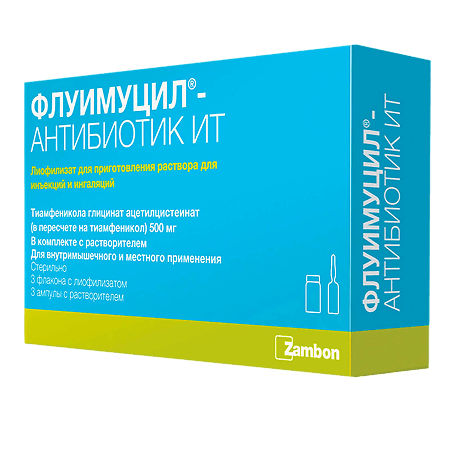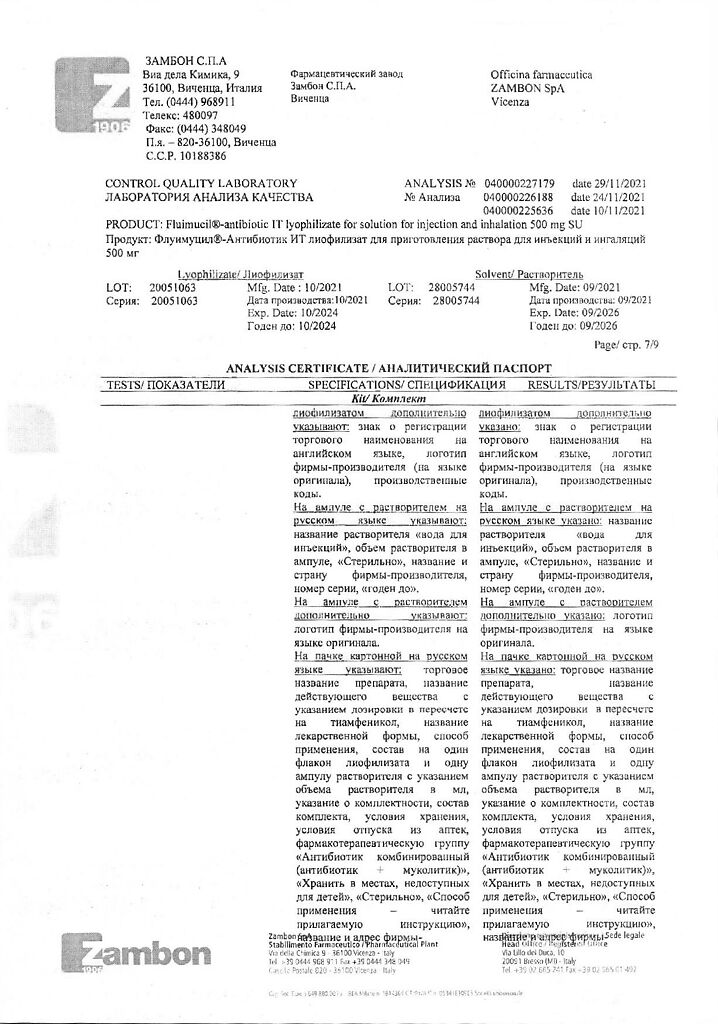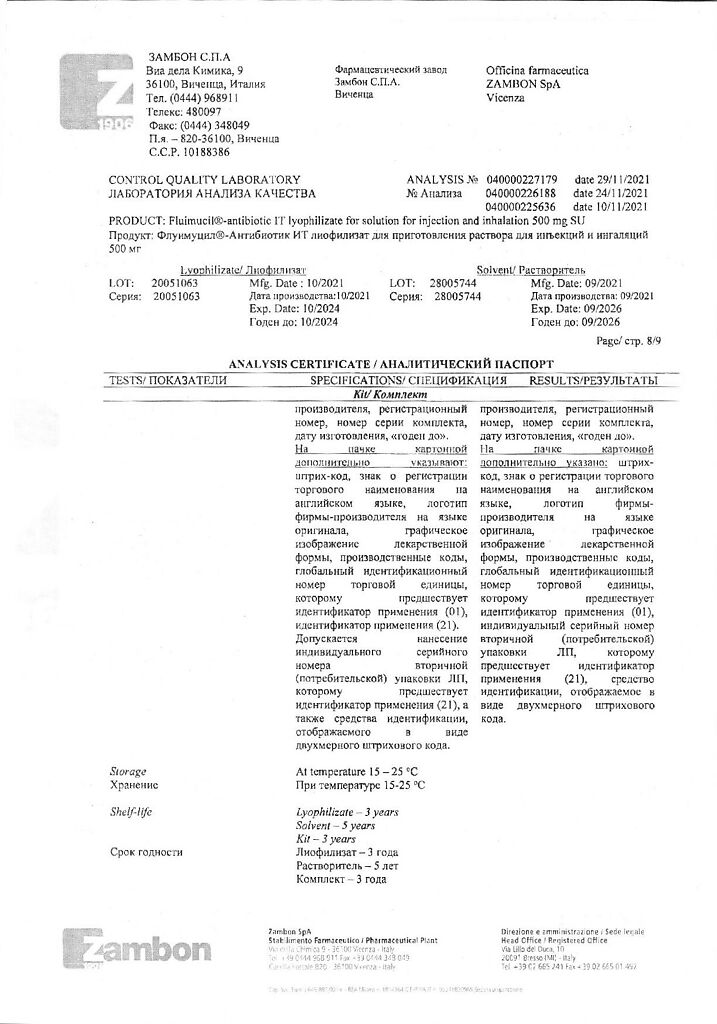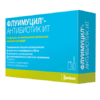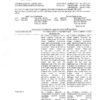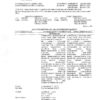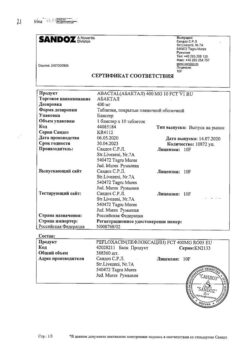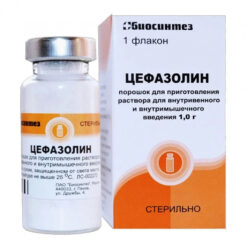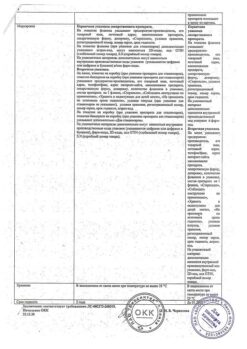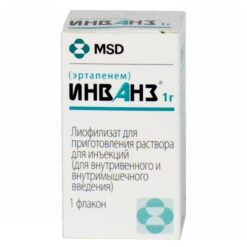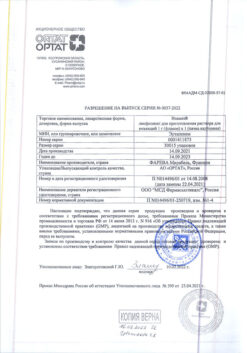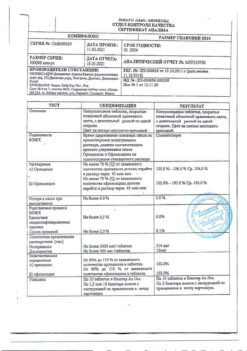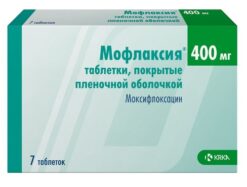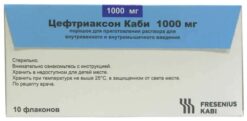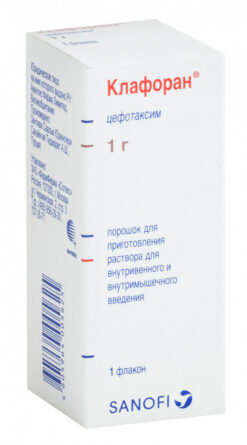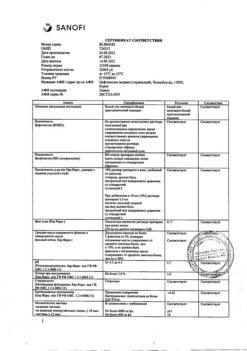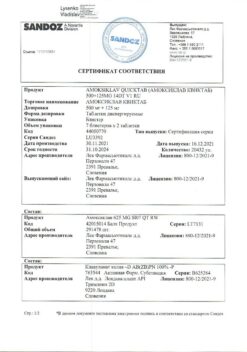No products in the cart.
Fluimucil-antibiotic IT, lyophilizate and inhalation 500 mg 3 pcs
€90.09 €84.63
Description
Pharmacotherapeutic group:
A combined antibiotic (antibiotic + mucolytic)
ATC code: [J01BA02].
Pharmacological properties
Pharmacodynamics
Thiamphenicol glycinate acetylcysteinate is a complex compound combining the antibiotic thiamphenicol and the mucolytic acetylcysteine. After absorption of thiamphenicol glycinate acetylcysteinate splits into acetylcysteine and thiamphenicol.
Thiamphenicol is a derivative of chloramphenicol, the mechanism of action is related to the inhibition of bacterial cell protein synthesis. Thiamphenicol has a wide spectrum of antibacterial activity, it is effective in vitro against the bacteria most frequently causing respiratory tract infections: Gram-positive (Streptococcus pneumoniae, Corynebacterium diphtheriae, Staphylococcus spp, Streptococcus pyogenes, Listeria spp., Clostridium spp.) and gram-negative (Haemophilus influenzae, Neisseria spp., Salmonella spp., Escherichia coli, Shigella spp., Bordetella pertussis, Yersinia pestis, Brucella spp., Bacteroides spp.)
Acetylcysteine by breaking disulfide bonds of mucoproteins quickly and effectively liquefies sputum, pus, reduces their viscosity and promotes expectoration. Acetylcysteine facilitates penetration of the antibiotic thiamphenicol into lung tissues and inhibits adhesion of bacteria on the airway epithelium.
Pharmacokinetics
Tiamphenicol is rapidly distributed in the body and accumulates in the respiratory tract tissues in therapeutic concentrations (tissue/plasma concentration ratio is about 1). Maximum plasma concentration is reached 1 hour after intramuscular administration. The elimination half-life is about 3 hours; the volume of distribution is 40 – 68 l. Binding to plasma proteins is up to 20%. It is excreted by the kidneys through glomerular filtration; 24 hours after injection the amount of unchanged thiamphenicol in the urine is 50-70% of the administered dose. It penetrates through the placental barrier.
Acetylcysteine is rapidly distributed in the body after administration, the half-life is 2 hours. In the liver it is deacetylated to cysteine. In blood there is a mobile equilibrium of free and bound to plasma proteins acetylcysteine and its metabolites (cysteine, cystine, diacetylcysteine). Acetylcysteine penetrates into the intercellular space, mainly distributed in the liver, kidneys, lungs, bronchial secretion. It is excreted by kidneys as inactive metabolites (inorganic sulfates, diacetylcysteine), a small part is excreted unchanged through the intestine. It passes through the placental barrier.
Indications
Indications
Fluimucil® antibiotic IT is used for the treatment of infectious inflammatory diseases caused by microorganisms sensitive to the drug and accompanied by mucostasis.
Diseases of the upper respiratory tract and ENT organs: exudative otitis media, sinusitis, laryngotracheitis.
Diseases of the lower respiratory tract: acute and chronic bronchitis, prolonged pneumonia, lung abscess, emphysema, bronchiectasis, cystic fibrosis, bronchiolitis, whooping cough.
Prevention and treatment of bronchopulmonary complications after thoracic surgery (bronchopneumonia, atelectasis). Prevention and treatment of obstructive and infectious complications of tracheostomy, preparation for bronchoscopy, bronchoaspiration.
With concomitant nonspecific forms of respiratory infections to improve drainage, including cavernous lesions, with mycobacterial infections.
Pharmacological effect
Pharmacological effect
Pharmacotherapeutic group:
combined antibiotic (antibiotic + mucolytic)
ATX code: [J01BA02].
Pharmacological properties
Pharmacodynamics
Thiamphenicol glycinate acetylcysteinate is a complex compound that combines the antibiotic thiamphenicol and the mucolytic acetylcysteine. After absorption of thiamiphenicol, glycinate acetylcysteinate is split into acetylcysteine and thiamphenicol.
Thiamphenicol is a derivative of chloramphenicol, the mechanism of action is associated with inhibition of bacterial cell protein synthesis. Thiamphenicol has a wide spectrum of antibacterial action, effective in vitro against bacteria that most often cause respiratory tract infections: gram-positive (Streptococcus pneumoniae, Corynebacterium diphtheriae, Staphylococcus spp., Streptococcus pyogenes, Listeria spp., Clostridium spp.) and gram-negative (Haemophilus influenzae, Neisseria spp., Salmonella spp., Escherichia coli, Shigella spp., Bordetella pertussis, Yersinia pestis, Brucella spp., Bacteroides spp.).
Acetylcysteine, by breaking the disulfide bonds of mucoproteins, quickly and effectively dilutes sputum and pus, reduces their viscosity and promotes discharge. Acetylcysteine facilitates the penetration of the antibiotic thiamphenicol into lung tissue and inhibits the adhesion of bacteria to the epithelium of the respiratory tract.
Pharmacokinetics
Thiamphenicol is rapidly distributed in the body, accumulates in the tissues of the respiratory tract in therapeutic concentrations (tissue/plasma concentration ratio is about 1). Maximum plasma concentration is achieved 1 hour after intramuscular administration. The half-life is about 3 hours, the volume of distribution is 40 – 68 l. Plasma protein binding up to 20%. It is excreted by the kidneys through glomerular filtration; 24 hours after administration, the amount of unchanged thiamphenicol in the urine is 50-70% of the administered dose. Penetrates through the placental barrier.
Acetylcysteine is quickly distributed in the body after use, the half-life is 2 hours. In the liver it is deacetylated to cysteine. In the blood, a mobile equilibrium of free acetylcysteine and its metabolites (cysteine, cystine, diacetylcysteine) is observed, free and bound to plasma proteins. Acetylcysteine penetrates into the intercellular space and is predominantly distributed in the liver, kidneys, lungs, and bronchial secretions. It is excreted by the kidneys in the form of inactive metabolites (inorganic sulfates, diacetylcysteine), a small part is excreted unchanged through the intestines. Penetrates through the placental barrier.
Special instructions
Special instructions
During treatment, peripheral blood patterns should be monitored. If the number of leukocytes (less than 4 thousand/μl) and granulocytes (by more than 40%) decreases, the drug is discontinued.
The dose of thiamphenicol should be reduced in moderate to severe renal failure. In addition, patients with moderate to severe renal impairment are recommended to be treated separately with antibacterial and mucolytic agents.
Fluimucil® IT antibiotic solution should not come into contact with metal and rubber surfaces.
For inhalation, it is recommended to use a compressor nebulizer; it should be configured so that the size of the sprayed particles is 3-20 microns. It is advisable to use a nebulizer made of glass or plastic. If the nebulizer has metal or rubber parts, they must be washed with water after use.
Impact on the ability to drive vehicles and operate machinery
Fluimucil® antibiotic IT does not affect the ability to drive vehicles and other mechanisms.
Active ingredient
Active ingredient
Thiamphenicol glycinate acetylcysteinate
Composition
Composition
1 bottle contains:
active substance:
thiamphenicol glycinate acetylcysteinate – 810 mg (in terms of thiamphenicol – 500 mg),
excipient disodium edetate 2.5 mg.
1 ampoule of solvent: water for injection 4 ml.
Pregnancy
Pregnancy
During pregnancy, the drug is prescribed only when the potential benefit to the mother outweighs the potential risk to the fetus.
If it is necessary to prescribe the drug during lactation, breastfeeding should be stopped during treatment.
Contraindications
Contraindications
Hypersensitivity to one of the components of the drug; anemia, leukopenia, thrombocytopenia.
With caution
For liver failure and chronic renal failure. In children of the first two years of life due to age-related characteristics of kidney function.
Side Effects
Side Effects
For systemic and local routes of administration – allergic reactions.
When administered intramuscularly, a slight burning sensation at the injection site, reticulocytopenia, anemia, leukopenia, neutropenia, thrombocytopenia, nausea, vomiting, and diarrhea are possible.
With long-term use, optic neuritis and peripheral neuropathy are possible.
With inhalation administration – reflex cough, local irritation of the respiratory tract, stomatitis, rhinitis, nausea. Laryngeal edema and bronchospasm are possible (mainly in patients with bronchial asthma), in which case bronchodilators are prescribed.
Interaction
Interaction
The simultaneous administration of antitussives may increase sputum stagnation due to suppression of the cough reflex.
It is not recommended to mix with other aerosol medications.
Overdose
Overdose
Symptoms: changes in bacterial flora, superinfections. The side effects of the drug may increase (with the exception of allergic reactions). Maintenance therapy is recommended.
Storage conditions
Storage conditions
At room temperature 15–25 °C
Shelf life
Shelf life
3 years
Manufacturer
Manufacturer
Zambon S.p.A., Italy
Additional information
| Shelf life | 3 years |
|---|---|
| Conditions of storage | At room temperature 15-25 °C |
| Manufacturer | Zambon S.p.A., Italy |
| Medication form | lyophilizate |
| Brand | Zambon S.p.A. |
Related products
Buy Fluimucil-antibiotic IT, lyophilizate and inhalation 500 mg 3 pcs with delivery to USA, UK, Europe and over 120 other countries.

